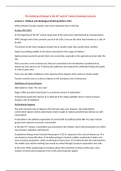Summary
The Ordering of Europe in the 20th and 21st Century Summary
- Course
- Institution
- Book
This lecture summary provides a detailed overview of information provided in the lectures of the course; going through thematically and chronologically. The course is taken in the Second year, as part of the major European History.
[Show more]





